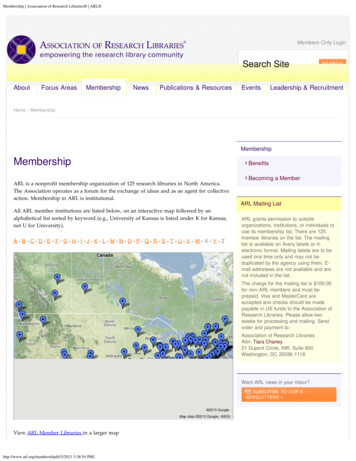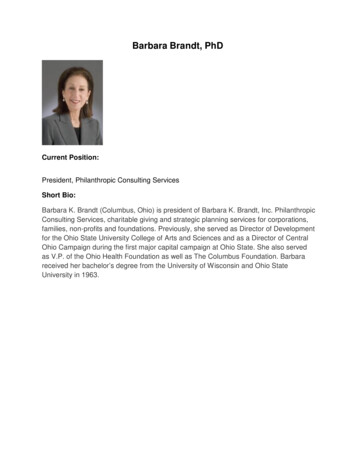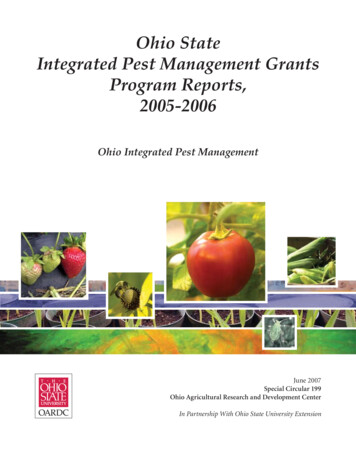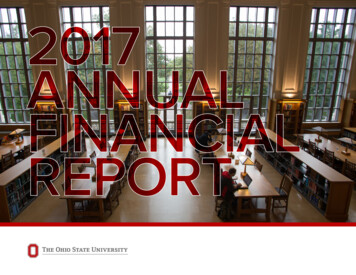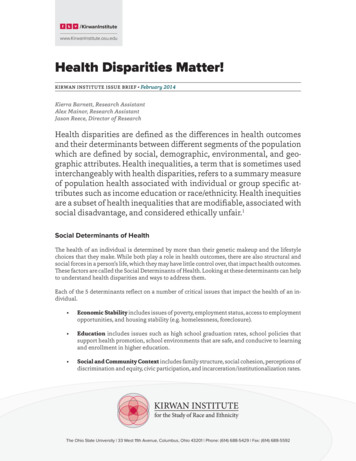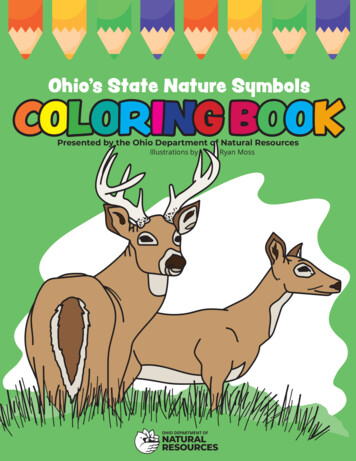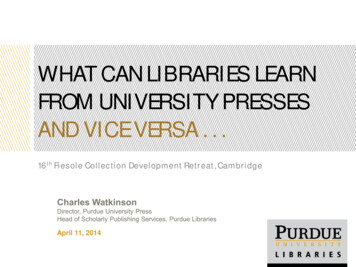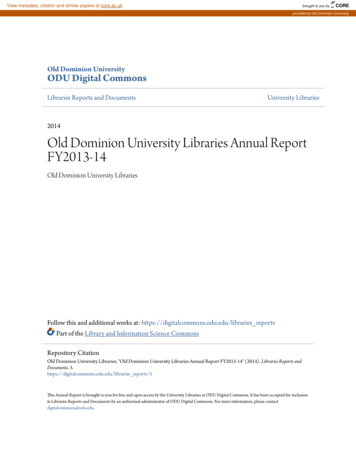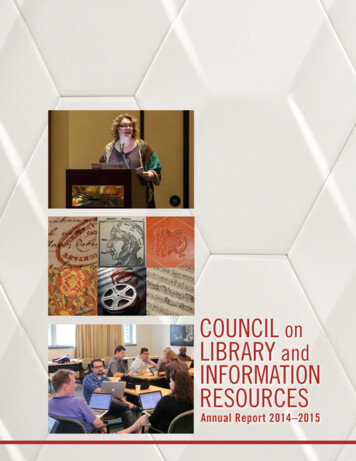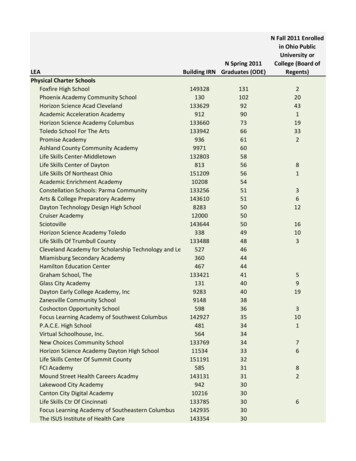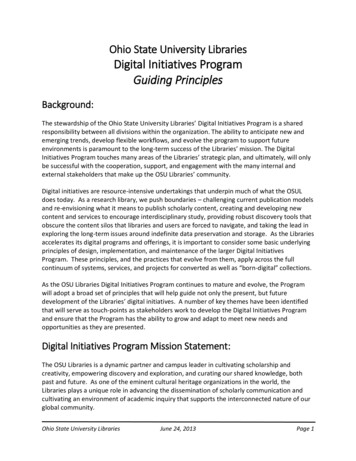
Transcription
Ohio State University LibrariesDigital Initiatives ProgramGuiding PrinciplesBackground:The stewardship of the Ohio State University Libraries’ Digital Initiatives Program is a sharedresponsibility between all divisions within the organization. The ability to anticipate new andemerging trends, develop flexible workflows, and evolve the program to support futureenvironments is paramount to the long-term success of the Libraries’ mission. The DigitalInitiatives Program touches many areas of the Libraries’ strategic plan, and ultimately, will onlybe successful with the cooperation, support, and engagement with the many internal andexternal stakeholders that make up the OSU Libraries’ community.Digital initiatives are resource-intensive undertakings that underpin much of what the OSULdoes today. As a research library, we push boundaries – challenging current publication modelsand re-envisioning what it means to publish scholarly content, creating and developing newcontent and services to encourage interdisciplinary study, providing robust discovery tools thatobscure the content silos that libraries and users are forced to navigate, and taking the lead inexploring the long-term issues around indefinite data preservation and storage. As the Librariesaccelerates its digital programs and offerings, it is important to consider some basic underlyingprinciples of design, implementation, and maintenance of the larger Digital InitiativesProgram. These principles, and the practices that evolve from them, apply across the fullcontinuum of systems, services, and projects for converted as well as “born-digital” collections.As the OSU Libraries Digital Initiatives Program continues to mature and evolve, the Programwill adopt a broad set of principles that will help guide not only the present, but futuredevelopment of the Libraries’ digital initiatives. A number of key themes have been identifiedthat will serve as touch-points as stakeholders work to develop the Digital Initiatives Programand ensure that the Program has the ability to grow and adapt to meet new needs andopportunities as they are presented.Digital Initiatives Program Mission Statement:The OSU Libraries is a dynamic partner and campus leader in cultivating scholarship andcreativity, empowering discovery and exploration, and curating our shared knowledge, bothpast and future. As one of the eminent cultural heritage organizations in the world, theLibraries plays a unique role in advancing the dissemination of scholarly communication andcultivating an environment of academic inquiry that supports the interconnected nature of ourglobal community.Ohio State University LibrariesJune 24, 2013Page 1
The Digital Initiatives Program plays an important role in the Libraries’ mission, providing themechanical and intellectual scaffolding that enables the OSU Libraries to create, preserve, anddisseminate digital forms of information both now and in the future. The Digital InitiativesProgram will ensure that the Libraries remains well positioned to continue supporting themission of the university and its communities, through the active assessment of the Libraries’digital infrastructure and policies and ensuring that our systems and processes evolve to meetthe changing needs of a large, dynamic research organization.Principles:A number of key principles have been identified that will guide the development of the DigitalInitiatives Program and the working group as it evaluates current and future systems, policies,services, and best practices. These principles underscore the changing nature of digitalenvironments and the need to embrace an environment that understands and anticipates theephemeral nature of technology while ensuring the durability of managed content. We build services, not productsThe OSU Libraries’ digital infrastructure will be conceived around the philosophy thatthe Libraries should be investing in the development of services, not one-offdevelopment projects. This represents the natural maturation of the OSUL’s DigitalInitiatives Program; moving from an environment that was tied to individual digitizationprojects and products, to a programmatic architectural approach that considers theissues of long-term sustainability, interoperability, preservation, and accessibility ofresources at OSUL and beyond. This approach should allow for the Libraries' sharingand leveraging of data to provide better integration, access, and discovery of content. We carefully weigh when to Build versus Buy versus BorrowThe development of the Libraries digital infrastructure must recognize the needs of theinstitution and weigh them against the Libraries’ desire to promote a culture of openaccess and open source development, and the Libraries’ current capacity to develop andsupport new services and systems. The development of the Libraries’ Digital InitiativesProgram will occur along a continuum of options, where tools and systems are selectedbased on the Libraries’ needs, support capacity, and a system or tool’s “fit” within thepresent environment. We develop modular services, not monolithic systemsThe Libraries’ Digital Initiatives Program will be developed around the philosophy thatsystems designed around modular services and components ultimately will provide agreater level of flexibility and encourage long-term innovation over traditionalmonolithic systems. The Libraries’ will utilize a “plug and play” philosophy, wheresystems and tools are simply building blocks of a larger whole. This approach willprovide the Libraries with the greatest flexibility by allowing the Libraries toOhio State University LibrariesJune 24, 2013Page 2
continuously evaluate the blocks that make up the larger architecture, and replacecomponents and tools as new, better options become available. We develop for changeIn order to be successful over the long-term, the Libraries’ Digital Initiatives Program willadopt a philosophy of continual change. The simple truth is, nothing isforever. Whether it is the digital object and the need to refresh or migrate formats asstandards change, or the iterative and incremental development of systems, services,and tools, the technology and processes that make up the Libraries’ Digital InitiativesProgram will always remain in a state of flux. By recognizing this fact, the Libraries’ willadopt a vision of iterative development. This vision will be marked by the followingtenets:o All things evolve – Regardless of the format, the system, or the people managingand developing a system, things will always be in a state of flux. Weacknowledge that and accept it as a part of the architectural design.o Plan for continuous improvements – The Libraries will use an agile approach tosystems development, adopting a philosophy of iterative development: releasesoon and release often, allowing the Libraries to move quickly and anticipatenew needs and services.o It’s OK to fail – In systems development, a certain amount of risk exists. It’s easyto react to trends, but difficult to anticipate future needs withoutexperimentation. Failure in this context is acceptable and periodically expected,so long as the Libraries is able to learn through the process, fail fast, and failforward, and not lose managed content.o Anticipating End-Of-Life – Whether it is a data format, a tool, a systemcomponent, services, or a best practice – anticipating the migration of data,systems, and workflows is a universal constant when working within a digitalenvironment. The Libraries will minimize the impact of these disruptions byproactively planning and preparing for these inevitable technology shifts. We don’t keep everything foreverWhile libraries understand the need to curate traditional print collections, few applythose principles of curation to the digital environment. The simple fact is, the Librarieswill not maintain all digital data forever, and the Libraries’ digital programs will need toprovide a clear process for managing the life cycle of the content that the Librariescurates as part of the OSUL's Digital Preservation Framework. However, this goesbeyond curation of content. Technology moves at a rapid pace, and the projects andservices created, used, and supported by the OSUL will need to change as well. TheLibraries' Digital Initiatives Program must be able to thrive in this ever changingenvironment, and include clear assessment metrics and documented exit procedures. We will build in assessmentThe Digital Initiatives Program will embed assessment into its processes. UtilizingOhio State University LibrariesJune 24, 2013Page 3
available data, stories, and user feedback, the Program will seek to continually assessProgram strengths, weaknesses, and needs as it moves forward. We focus on the userThe OSUL will strive to create a user friendly environment, developing intuitive services,and systems that support the Libraries' strategic mission in advancing discovery andlearning. Utilizing techniques such as focus groups, user feedback, and testing, theOSUL will strive to provide a superior, user-focused environment. We work with partnersA digital initiatives program is a very complex undertaking, and its success will dependupon leveraging partnerships within the Libraries, across the University, and withstakeholders external to OSU.o Partners, not customers: One of the benefits of adopting an agile developmentenvironment is the necessity for close partnerships between IT departments(Digital Initiatives, Applications Development & Support, and InfrastructureSupport) and the Libraries as a whole. Going forward, the expectation is thatlibrarians and IT will work collaboratively throughout the life-cycle of a project.o Excellence to Eminence: As the University and the OSUL strive to embrace themove from excellence to eminence, one aspect of that transformation is theparticipation in large, national and international collaborations. Nationally andinternationally, issues related to digital initiatives, preservation, semantic data,repositories, etc. are being actively researched. OSUL must strive to find a placeat that table, and look for strategic opportunities to build new and excitingpartnerships outside the University, and with the larger library community. We embrace research as a core, fundamental valueOne of the fundamental purposes of a university is to cultivate research at all levels,including systems development. This goes beyond the development of new services toconsidering the fundamental shifts occurring in libraries and positioning the OSUL to bea significant contributor and valued partner as the library community wrestles withthese issues. The need to research, experiment, and push boundaries must be a corepart of the program. We strive to stay grounded in the real worldThe pace of technological change can be dizzying as is the wide range of new services,systems, and best practices available. The Digital Initiatives Program will seek tocultivate an environment of experimentation and innovation, while staying grounded inthe knowledge that local needs must be met. While these two values can sometimesclash, the Program will seek to provide a balance between innovation and the need tobring together collections and people through the engagement and integration ofscholarship and instruction.Ohio State University LibrariesJune 24, 2013Page 4
We are driven by standardsForecasting the future is never an exact science. Like a meteorologist, we look atavailable information and make the best decisions that we can. And while we may notalways hit the mark, standards provide the touchstones that will keep the OSU Librariesgrounded. Standards apply to all areas of a digital initiatives program. They can befound in project management and the need to utilize systematic approaches to planningand development. Standards also inform our decisions around object formatting andreformatting, metadata schemas and vocabularies, and system interoperability anddesign. The Digital Initiatives Program will work with the OSUL and its partners to helpthe Libraries navigate these sometimes muddy waters to ensure that we are following abest set of standards and practices. Utilizing well-established international and nationalstandards over locally created best practices, OSUL will strive to create anenvironment that will support long-term sustainability and promoteinteroperability between services, assets, and systems, both locally and with ourpartners.The Digital Initiatives Program Principles provide the OSUL with a framework for making andevaluating decisions related to the development and implementation of a long-term digitalservices architecture. These Principles reflect the changing nature of the OSUL’s digitalprograms, shifting the focus from individual projects to a holistic program designed around anevolving services architecture. The Principles illustrate for the Libraries and its stakeholders thecore values and long-term direction of the Digital Initiatives Program.Submitted by the Strategies for Digital Initiative Working Group, June 24, 2013.Approved by the Libraries Executive Committee, June 25, 2013.Ohio State University LibrariesJune 24, 2013Page 5
principles of design, implementation, and maintenance of the larger Digital Initiatives Program. These principles, and the practices that evolve from them, apply across the full . systems, and best practices available. The Digital Initiatives Program will seek to cultivate an environment of experimentation and innovation, while staying .
